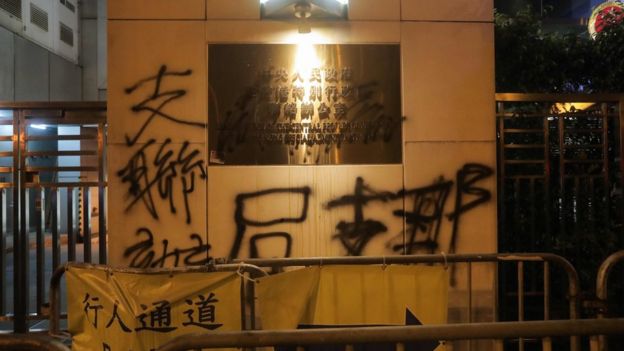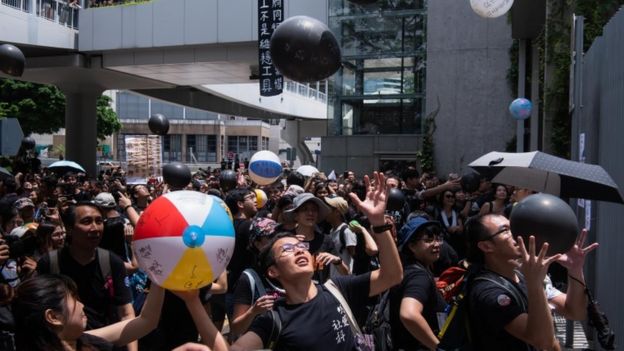Hong Kong protests: High security as masses march
Tens of thousands of people are marching in Hong Kong amid tight security, in the latest protest organised by pro-democracy groups.
Mass protests have been held for weeks, initially over an extradition deal with mainland China but now covering other issues on democracy in Hong Kong.
Protesters on Sunday have ignored the designated finish line, continuing on to China’s central government building.
Many protesters are now involved in a stand-off with police.
Riot police say a clearance operation will begin in the Central area of Hong Kong, which lies outside the designated route.
Earlier in the day, protesters threw eggs at the liaison office, China’s central government building. Images from outside the building show signs covered in graffiti.
 Protesters threw eggs at the Liason office’s sign on Sunday
Protesters threw eggs at the Liason office’s sign on SundayThe latest rally was put on edge after a huge haul of explosives was found along with protest leaflets.
On Saturday, a counter-rally in support of the police and against protest violence drew tens of thousands.
Tear-gas, rubber bullets, the trashing of parliament by protesters and sporadic clashes have created the worst crisis in the territory’s recent history.
The Hong Kong government has since suspended trying to pursue the extradition bill.
The former British colony is part of China but run under a “one country, two systems” arrangement that guarantees it a level of autonomy. It has its own judiciary, and a legal system that is independent from mainland China.
What is happening on Sunday?
It’s the seventh consecutive weekend of mass demonstrations and tens of thousands are marching at the traditional protest point on Hong Kong Island.
 The pro-democracy protests show little sign of abating
The pro-democracy protests show little sign of abatingHowever, the route has been altered and is scheduled to stop at Wan Chai rather than Central, where the key government offices are located.
But pro-democracy legislator Claudia Mo told Reuters news agency: “I think many people will just march on towards Central.”
She said the police were “terribly worried” about possible violence around the government and legislative complexes and police headquarters.
Metal barriers traditionally used to channel or keep out protesters – which have been taken by some of them to create barricades – have now been replaced by water-filled versions around key buildings.
Some 4,000 police officers have been deployed.
Previous marches have largely been peaceful, but have sparked violence on the fringes. Last weekend’s protests left 28 people, including 13 police officers, injured.
Is the explosives find linked?
Hong Kong police are still investigating. Three men are under arrest.
Officers discovered the haul when they entered an industrial building in the Tsuen Wan district on Friday evening.
They said they found 2kg (4.4lb) of the highly volatile TATP, as well as 10 petrol bombs, acidic substances, weapons including knives and metal rods, and gas masks and goggles.
There were also banners and leaflets opposing the extradition bill and a T-shirt bearing the logo of the pro-independence Hong Kong National Front group.
What was the counter-protest about?
It took place in the central Hong Kong district of Admiralty on Saturday, attracting 103,000 people according to police, but more than 300,000 according to organisers. “You are fake news” – BBC correspondent heckled live on air during Saturday’s rally
“You are fake news” – BBC correspondent heckled live on air during Saturday’s rally
It was themed “Safeguard Hong Kong”. The South China Morning Post said attendees included locals, mainland immigrants, members of ethnic minorities and visitors from across the border.
The rally, which won coverage in Chinese state media, focused on support for the police and condemnation of the violence that has marred pro-democracy rallies.
Views differed, however, on how the Hong Kong government had tackled the crisis.
How did the protests start?
They were sparked by the proposed extradition bill that would have allowed people to be sent to China for trial.
Critics said it would undermine Hong Kong’s judicial independence and could be used to target those who spoke out against the Chinese government.
The Hong Kong government suspended the bill, but this has not halted the demonstrations, which now reflect broader demands for democratic reform and concerns that freedoms are being eroded.



